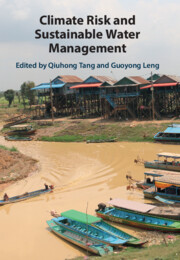Book contents
- Climate Risk and Sustainable Water Management
- Climate Risk and Sustainable Water Management
- Copyright page
- Contents
- Contributors
- Preface
- Acknowledgements
- Part I Water-Related Risks under Climate Change
- Part II Climate Risk to Human and Natural Systems
- Part III Sustainable Water Management under Future Uncertainty
- 15 Managing Urban Flood Risk and Building Resilience in a Changing Climate
- 16 Soft Computing Methods and Water Management
- 17 Rainwater Harvesting for Sustainable Water Resource Management under Climate Change
- 18 Variability of Runoff Coefficient and Precipitation Elasticity at Watersheds across China
- 19 Contribution of Hydrological Model Calibration Uncertainty to Future Hydrological Projections over Various Temporal Scales
- 20 Future Water Scarcity over the Yellow River Basin and the Effects of Adaptive Measures
- 21 Shrinking Lake Urmia
- Index
- References
19 - Contribution of Hydrological Model Calibration Uncertainty to Future Hydrological Projections over Various Temporal Scales
A Case Study in the Boulder Creek Watershed
from Part III - Sustainable Water Management under Future Uncertainty
Published online by Cambridge University Press: 17 March 2022
- Climate Risk and Sustainable Water Management
- Climate Risk and Sustainable Water Management
- Copyright page
- Contents
- Contributors
- Preface
- Acknowledgements
- Part I Water-Related Risks under Climate Change
- Part II Climate Risk to Human and Natural Systems
- Part III Sustainable Water Management under Future Uncertainty
- 15 Managing Urban Flood Risk and Building Resilience in a Changing Climate
- 16 Soft Computing Methods and Water Management
- 17 Rainwater Harvesting for Sustainable Water Resource Management under Climate Change
- 18 Variability of Runoff Coefficient and Precipitation Elasticity at Watersheds across China
- 19 Contribution of Hydrological Model Calibration Uncertainty to Future Hydrological Projections over Various Temporal Scales
- 20 Future Water Scarcity over the Yellow River Basin and the Effects of Adaptive Measures
- 21 Shrinking Lake Urmia
- Index
- References
Summary
In this study, we applied a multi-objective calibration approach to select a group of best performing parameter sets for the Variable Infiltration Capacity (VIC) model in the Boulder Creek Watershed, USA. We specifically applied 16 non-dominated parameter sets to simulate hydrologic variables, including streamflow (Q), evapotranspiration (ET) and soil moisture (SM) in two future phases (Phase 1: 2040–2069; Phase 2: 2070–2099). Relative to the historical period, Q and ET increased, and SM decreased. The magnitude of change was greater in Phase 2 than in Phase 1 for both ET (+19.7 per cent) and SM (-5.4 per cent). We found that the model calibration resultant parameter uncertainty could lead to a reversal of the change sign of annual Q during Phase 2. The uncertainty resulting from model calibration was up to 4.3 per cent and 19.6 per cent at the annual and monthly scales, respectively. Seasonally, uncertainty reached the highest levels during the spring snowmelt runoff period between February and May for Q and SM, and during the summer months for ET. These results suggest that the use of a single parameter set may yield substantial bias for hydrological projections, and more efforts should be devoted to constraining the model calibration uncertainty to enable effective water resources decision-making.
Keywords
- Type
- Chapter
- Information
- Climate Risk and Sustainable Water Management , pp. 420 - 444Publisher: Cambridge University PressPrint publication year: 2022

